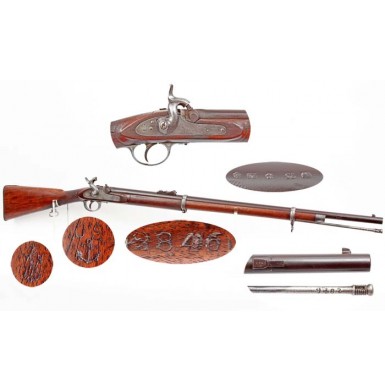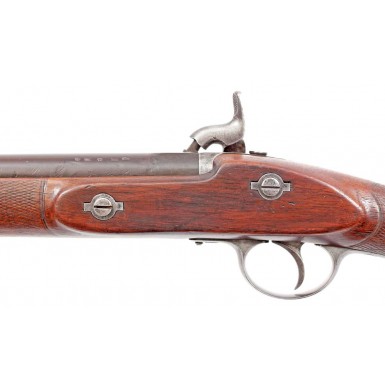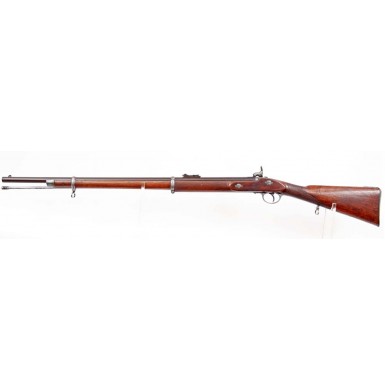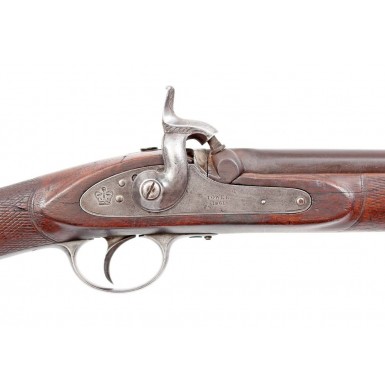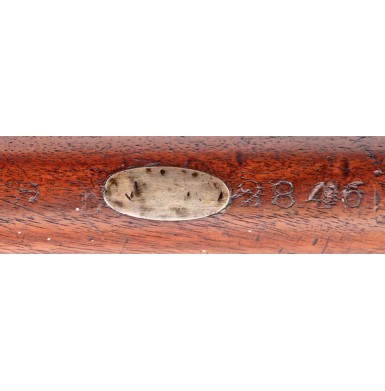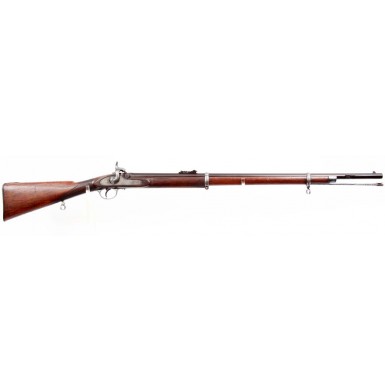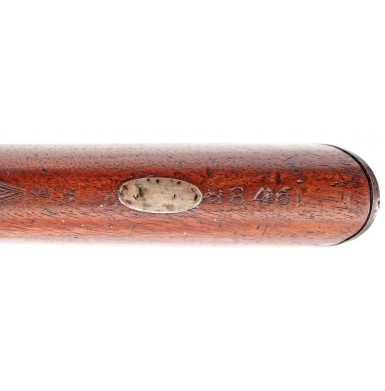Confederate Imported P-1856 Rifle with JS/Anchor & CS Numbers
- Product Code: FLA-2784-SOLD
- Availability: Out Of Stock
-
$1.00
This is a FINE condition example of a rarely encountered Confederate imported P-1856 Iron Mounted “Short Rifle”. The gun bears the highly desirable Confederate J S / (ANCHOR) viewer’s mark behind the triggerguard, and has the Confederate inventory number 2846 stamped in the wood of the belly of the stock, and engraved on the end of the ramrod. During 1861 and 1862, the Confederacy entered into a several contracts for the delivery of “Enfield” pattern percussion long arms of all varieties. Many of these contracts are well documented in the papers of Confederate General Colin McRae, which now reside in the collection of the South Carolina Relic Room & Military Museum, in Columbia, SC. While the purchases concentrated on P-1853 Enfield rifle muskets for use by Confederate the infantry, a number of Enfield pattern “short rifles’ and carbines (both artillery and cavalry) were obtained as well. Confederate documents reveal that one of the early orders included 30,000 P-1853 “Long Enfields’ (obtained from Sinclair, Hamilton & Company), as well as 10,000 “short rifles’ of varying patterns. The 40,000 guns from these contracts are the ones that are found with the both the J S / (ANCHOR) viewer’s mark and Confederate inventory number markings. The “Long Enfields’ were serialized in three series, from 1-10,000, 1-10,000 with an “A” suffix and 1-10,000 with a “B” suffix (although no gun bearing “10,000” has ever been encountered). The short rifles were simply numbered in their own series from 1-10,000 without any letter suffixes. The short rifles were a mixture of standard P-1856 and P-1856 Type II (also known as the P-1858 or “Bar on Band”) iron mounted rifles, as well as non-standard brass mounted P-1856 and P-1856 Type II rifles. A handful of the brass mounted P-1858 Naval Rifles, and iron mounted P-1860 and P-1861 rifles were also purchased. Many of the earliest Confederate short rifle purchases took the form of “Volunteer Rifles”, which were enhanced and embellished commercial versions of the standard military rifles. These guns were intended for sale to the local British “Volunteer” units, which were essentially the local militias that were as much shooting clubs and social organizations as they were quasi-military units. Several “short rifles’ with checkered stocks, engraved metal and other upgraded features are known with Confederate importation marks on them. The Pattern 1856 Short Rifle was the standard British military rifle of the era, and had a 33” barrel, with a .577 caliber bore which was rifled with 3-groove, progressive depth rifling. The rear sight was graduated to 1,100 yards (rifle musket sights were graduated to 1,000 yards), and was set just behind the rear barrel band; further forward on the barrel than the sights used on the rifle musket. The rifle was equipped with a bayonet lug on the right side of the barrel, near the muzzle, to accommodate a Yataghan blade saber bayonet. The earliest production rifles had a short “key” or “lead” forward of the actual lug, but this feature was quickly eliminated and the majority of P-1856 rifles have lugs without that short guide. The rifle had a rear sling swivel attached to a lug, screwed into the rear of the extended iron triggerguard tang, and the upper swivel attached to the upper barrel band. As with the P-1853 rifle muskets, the iron mounted rifles had blued barrels and color case hardened locks and hammers. The furniture (triggerguard, butt plate, stock escutcheons, nose cap, etc) of the “iron mounted” rifles was made of iron rather than brass, and was color casehardened as well. Due to the difficulty of engraving a numbers in the case hardened buttplate tang, the iron mounted rifles that were inventory numbered were stamp-marked with their numbers in the wood of the stock belly. Short rifles were lighter and handier than rifle muskets and were preferred for use not only by Confederate infantry that functioned as skirmishers and sharpshooters, but by Confederate cavalry that tended to operate as mounted infantry, rather than as traditional heavy cavalry. Confederate cavalry commanders J.E.B. Stuart and Nathan Bedford Forrest were both proponents of issuing short rifles to their cavalry troopers. Short rifles with saber bayonets are known to have been issued to Confederate infantry regiments serving in Kershaw’s South Carolina Brigade, the 10th, 16th, 18th & 51st Georgia, the 13th, 17th, 18th & 51st Mississippi, the 41st Tennessee, the 1st Battalion of Texas Sharpshooters, and the 5th Texas. Mounted Confederate units that are known to have been issued the “short Enfield rifle” were Cobb’s & Phillip’s Legions of Georgia, the 18th & 19th Mississippi cavalry (McCulloch’s Brigade of Forrest’s 2nd Cavalry), the 2nd North Carolina cavalry, the 3rd, 6th, 9th & 27th Texas cavalry (Ross’ brigade) and the 7th Virginia cavalry. Today, a multi-decade survey of extant surviving Confederate marked and inventory numbered Enfield short rifles reveals that less than 100 of these guns have survived (about 1% of the total purchased). While some are in private collections, many others reside in museum or other public collections where they can be viewed, but never owned by a collector.
This Confederate purchased P-1856 Iron Mounted Rifle is in about FINE condition and has a wonderful, untouched and fresh from the attic patina. The gun is a very high quality example of a Volunteer pattern short rifle, and has a number of features not regularly encountered on standard British military rifle of the era. The rifle has a checkered wrist and forend, a hook breech, a German silver escutcheon in the toe of the stock and a target grade Siddons patent lock. William Siddons was a Gun Lock Maker who received English Patent #1786 on August 8, 1854 for a “friction reducing lock mechanism”. Siddons high quality locks were highly coveted and are often encountered in the higher-grade guns produced by Thomas Turner of Birmingham. Siddons started his business in 1817 and became Siddons & Sons in 1855, with the company going out of business in 1866. During the Civil War era, they were located at 16 St. Mary’s Row & Whittall Street. The gun has clearly seen service in the field, but remains amazingly complete and in wonderful condition for a Confederate used long arm that likely served for almost the entire war. The lock of the rifle is clearly marked with the usual English Crown to the rear of the hammer and TOWER / 1861 forward of the hammer. The interior of the lock is marked SIDDON’s PATENT along with the initials HH and the mating mark X \ / along the top edge of the lock plate. The lock is particularly smooth and has a nice trigger pull, much nicer than a standard military rifle. The hammer has the slightly curled spur that is typical of the earliest (Type 1) P-1853 rifle muskets, as well as the earlier P-1842 muskets. The case hardened lock has “silvered-out” to an attractive silvery gray patina with some very minute traces of case colored mottling, and some scattered pinpricks of darker age oxidation. The lock is mechanically excellent and functions well on all positions. The top of the barrel is marked with the usual Birmingham commercial provisional proof, view and definitive proof marks, as well as a pair of 25 gauge marks, indicating .577 caliber. The barrel is mostly smooth metal forward of the rear barrel band, with light to moderate scattered pinpricking and light peppering from the sight forward along its entire length. There is some light to pitting present around the breech and bolster area, extending to the rear barrel band. The barrel has a deep, dark chocolate brown patina that is untouched and very attractive. The bore of the rifle has been bored smooth and it retains no discernable rifling. This is unfortunate, as the hook-breech barrel is a very finely made, target quality barrel. The bottom of the barrel is marked with the same initials HH as found in the lock, likely the mark of the assembler or “Setter Up” of the rifle. It also bears the same mating mark as found on the edge of the lock, X \ /. This mating mark appears on the bottom of both the false breech and the barrel. The bottom of the barrel is additionally marked with Birmingham proof and gauge marks, as well as the name T TURNER, who was likely the manufacturer of this fine quality rifle. As a Confederate purchase, the gun bears the expected the J S / (ANCHOR) viewer’s mark behind the triggerguard and has the Confederate inventory number 2846 stamped in the toe of the stock. There is also a small (CROWN) / B / ST / A (Birmingham Small Arms Trade) mark in the wood behind the triggerguard as well. The keyed bayonet lug is marked with the mating code 684 / JP. This same code would be found on the pommel cap of the Type I P-1856 saber bayonet that was fit to the rifle. The bayonet would also carry the engraved Confederate inventory number on the left side of the pommel cap, where the catch release button is located. The original numbered ramrod for the rifle is in place in the channel under the barrel, and bears the matching number 2846, engraved near the jag head. The rod is full length and retains threads at the end. The rifle retains its original and correct 1,100 yard rear sight, as well as both original sling swivels. The small stud, forward of the triggerguard, that secured the snap cap (Cone protector) is broken off and missing. The barrel band tension screws retain both a screw-protecting doughnut on their ends. The rear band retains its original protector, while the protector on the forward band appears to an original, but more recent replacement. The iron furniture has a smooth, slivery-gray patina, which matches the patina on the lock of the rifle. The stock of the rifle rates about FINE. The stock is full-length with no breaks or repairs. The stock does show a significant number of bumps, dings and impact marks from actual use and service in the field. There are a couple of very minor surface grain cracks present, one forward and one to the rear of the lock mortise. These are tight and solid and do not appear structural. They do not affect the display of this wonderful Confederate rifle, but are mentioned for exactness. The checkering on the stock at the wrist and forend remains distinct, but has been worn smooth from years of handling, and significant service and use in the field. Considering that the gun arrived in the Confederacy no later than early 1862, and clearly fought long enough to be arsenal refurbished, the stock is in amazingly good condition. The stock retains good edges, although the lines are somewhat rounded and smoothed from handling and use. This wear and minor rounding of the sharp lines appears to be from natural use and not the result of any sanding.
Overall this is a really fine example of a very scarce Confederate marked and numbered P-1856 Short Rifle. With only 10,000 numbered short rifles having been purchased by the Confederacy for the Army (the CS Navy purchased 1000 numbered Naval Rifles as well), these guns are hardly common and are not often found for sale. In fact, a database that has recorded extant Confederate numbered rifles that have been inspected over the last 2-3 decades reveals that less than 100 of those 10,000 guns have survived, a survival rate of only 1%. Interestingly, only three numbers have been documented above the 28XX range, suggesting their hard use during the war resulted in many being lost or destroyed. Additionally, less than 25 of the surviving “short rifles’ retain their original, matching numbered ramrod. This is a simply wonderful example of a very high grade Enfield rifle that was almost certainly purchased by Confederate agents directly from an English gun shop during the early days of the war. The gun was certainly in the Confederacy no later than the spring of 1862 and subsequently fought the majority of the war. It is actually amazing that it has survived in such wonderful, untouched condition (with the exception of the smoothed bore), after seeing that much service. Any collection of CS imported long arms needs at least one numbered short rifle to complete it, and this is a wonderful opportunity to obtain a really great example that is completely authentic and correct in every way, and that retains its highly coveted, original, numbered ramrod.
SOLDTags: Confederate, Imported, P, 1856, Rifle, with, JS, Anchor, CS, Numbers

